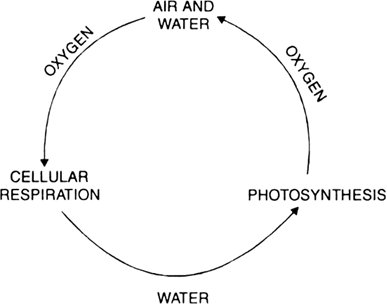Draw a labelled diagram to show the oxygen cycle in nature.
Or
Draw a neat labelled diagram to show the oxygen cycle in nature.
Or
Describe oxygen cycle in nature.
Oxygen cycle. Oxygen in gaseous form is present in atmosphere (21 per cent). In water bodies, it is present in dissolved form. From these sources, plants, animals and decomposers take molecular 02 for respiration.
Burning of fuels such as coal, wood, petroleum also use atmospheric 02.
Green plants utilize C02 and H20 during photosynthesis and release molecular 02 in air and water.

Fig. 14.3. Oxygen cycle.
Q. 21. Energy transfer is said to be unidirectional whereas biogeochemical transfer is said to be cyclic. Why ? (CBSE 1991)
Ans. There is continuous flow of energy from the sun to the living system. Because, there is continuous loss of 90% energy as heat in transfer from trophic level to the next trophic level i.e., from producer (green plants) to the herbivores to the carnivores. The lost as heat get lost in the space and never returns to the sun. Therefore, the transfer of energy is always unidirectional i.e., from the sun to the living system.
The minerals locked up in the bodies of living things get back into the soil because, the decomposers release them from the parts of the living things or from the products or excreta of the living things. The mineral thus, released are reutilised by the plants and being recirculated in the system. So, the circulation of minerals is cyclic in nature.
State, why a car parked in the sunshine with its windows closed is found much more hot inside than outside?
What are aerosols? How are these dangerous?
What is the function of decomposers in Biogeochemical cycles?
Burning of fossils fuels causes pollution. Comment.